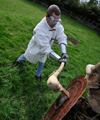September
Cutting edge research

Newcastle University researchers are bringing the past to life with an experiment to find out how people fought in the Bronze Age.
Experts in archaeology are testing a range of replica weapons - swords, axes, spears and shields using attacks and defences from modern and historic army tactics - to understand how they were used for fighting and killing.
The weapons will then be studied with sophisticated use-wear analysis techniques to see how the marks and damage compares with Bronze Age weapons in museum collections. The experts hope their findings will shed new light on life during the period.
Project leader Dr Andrea Dolfini, a lecturer in later prehistory at Newcastle University said: “This is a wonderful opportunity for us to learn more about how these weapons that we see in collections all over the world, were really used.
“The Bronze Age was the first time people used metal specifically to create weapons they could use against other people; in understanding how they used them, we will understand more about Bronze Age society.
“Previous research has looked at marks on weapons in one-to-one fights but we are also trying to replicate small-group combat situations as this would result in different markings on the metal.
“Already during our testing we have observed marks made by certain sword strikes which we have seen on artefacts. By doing these experiments we are hoping to understand exactly how these marks were generated and in what kind of combat encounters.
“The testing is fun and our volunteers have enjoyed trying out the weapons in a variety of ways but the real work will start when we take the weapons back to the lab and put them under the microscope.”
Trained volunteers wearing protective clothing are trying a wide variety of sword strikes delivered to different body parts. They executed parries with the sword edge, the sword flat, and the shield.
Shields were then mounted onto two targets, one man-size and one larger for strikes the team considered too dangerous to be carried out against an opponent. The targets were used for sword thrusts , axe attacks, and spear combat. The latter included both thrusts and throws carried out from different distances, with different spear-heads, and with shafts of different length.
The weapons were cast by traditional bronze smith Neil Burridge (Bronze Age Craft) using 12 per cent tin-bronze, and their edges were subsequently work-hardened and sharpened. The sword handles and pommels are made from oak, while the spear shafts and axe handles are seasoned ash.
Two shields, faithful copies of the prehistoric Clonbrin shield from Ireland, were made using vegetable-tanned leather hide. They were shrunk in hot water and beaten into a wooden former, then carefully dried and coated in bees' wax.
The team presented their preliminary findings on Wednesday at the British Science Festival, which is being hosted by Newcastle University.
published on: 13 September 2013
